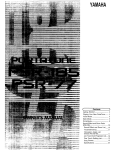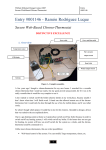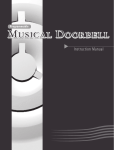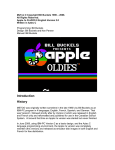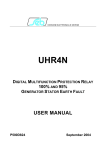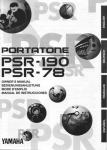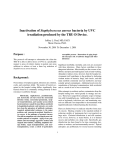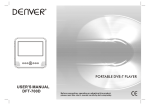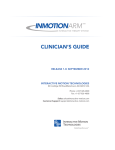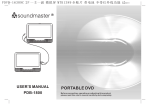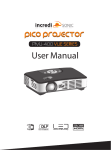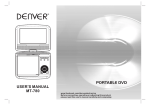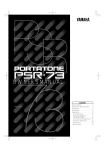Download PRODUCT MANUAL
Transcript
YAMAHA AUTHORIZED PRODUCT MANUAL YAMAHA Contents Owner’s Manual Main Features ...................... 1 Precautions ......................... 1 Getting Started ................... 2 Playing Your New PortaTone .................... 3 VOICE ............................... 4 STYLE ............................... 5 SONG ................................ 8 DRUM PADS (PSR-150) ............................. 9 SOUND EFFECT PADS (PSR-150)............................. 9 Troubleshooting .................. 10 Song Scores ..................... 11 Specifications ..................... 22 Congratulations on your purchase of the Yamaha PortaTone! You now own a portable keyboard that packs advanced functions and great sound in a highly compact size. Its outstanding features also make it an exceptionally expressive and versatile instrument. Read this Owner’s Manual carefully while playing your new PortaTone, and you will soon be able to make full use of its various features. Main Features The PortaTone is a sophisticated musical instrument with the following features and functions: 100 AWM (Advanced Wave Memory) Voices, utilizing digital recordings of actual instruments. (See VOICE, p.4.) Versatile music styles (50 on the PSR-150, 25 on the PSR-75). (See STYLE, p.5.) Demonstration Songs (Songs for playing along with when using the Minus-one function; 20 on the PSR-150, 15 on the PSR-75). (See SONG, p.8.) Specially programmed rhythms and chord progressions (20 on the PSR-150, 15 on the PSR-75). (See JAM TRACK, p.8.) Drum and percussion sounds for playing (PSR-150). (See DRUM PADs, p.9.) Special sound effects for playing (PSR-150). (See SOUND EFFECT PADS, p.9.) High-quality amplifier/speaker system (stereo for the PSR-150). Precautions – Taking Care of Your PortaTone Avoid applying excessive force to the controls, Your new PortaTone is a fine musical instrukeys and connections. ment – and should be treated as such. When Not Using the PortaTone Handle it with care and common sense, and After use, always turn off the POWER switch. it will give you years of enjoyment. When not using your PortaTone for long periods, be sure to remove the batteries to avoid damage through battery leakage. Location Avoid exposure to direct sunlight or other sources of heat. Never leave it inside a car where it can get very hot. Also avoid highly humid or dusty places. Cleaning Clean the exterior with a soft, dry cloth. To remove stubborn stains, use a slightly moistened cloth. Never use alcohol, thinner, or other chemical Interference from Electromagnetic Fields solvents, since they will damage the finish. Also, do not leave vinyl chloride material on the PortaTone for a long time, since it may adhere to the exterior. Do not use your PortaTone close to television sets, radios or similar equipment since this may cause interference noise in the other appliance. Handling Note: Protect your PortaTone from strong impact. Be careful not to drop it or place heavy objects on it. Yamaha is not responsible for damage caused by improper usage. 1 Getting Started When the Batteries Run Down Power Requirements When the batteries run low and the battery voltage drops below a certain level, the PortaTone may not sound or function properly. As soon as this happens, replace them with a complete set of six new batteries. NEVER mix old and new batteries. Your PortaTone can run either on batteries (sold separately) or on normal household current by using one of the optional Yamaha PA-3/4/40 Power Adaptors. Using an AC Power Adaptor To connect your PortaTone to a wall socket, you will need the optionally available Yamaha PA-3/4/40 Power Adaptors. Use of other AC adaptors could result in damage to the PortaTone and/or Power Adaptor, so be sure to ask for the right kind. Plug the adaptor into a convenient wall socket and its connector into the DC 9-12V IN jack on the back of your PortaTone. Accessory Jacks Using Headphones For private practicing and playing without disturbing others, connect a set of stereo headphones to the rear panel HEADPHONES/AUX. OUT jack. Sound from the built-in speaker system is automatically cut off when you insert a headphone plug into this jack. Inserting Batteries Turn the instrument upside-down and remove the battery compartment lid. Insert six 1.5volt size “D” batteries as shown in the illustration, making sure that the positive and negative terminals are properly aligned. Replace the lid. Connecting a Keyboard Amplifier or Stereo System After making sure the PortaTone and any external devices are turned off, connect one end of a stereo audio cable to the LINE IN or AUX. IN jack(s) of the other device and the other end to the HEADPHONES/AUX. OUT jack of the PortaTone. 2 Playing Your New PortaTone to each song on the panel. For example, to select Song 09, first press “0” on the Numeric Keypad, then “9.” You can skip this step and go on to step 2 below if you wish to play all songs continuously in succession, starting with Song 00. This section briefly shows you how to select from among the various Voices and Styles by using the Numeric Keypad. Selecting Modes Your PortaTone can be made to operate in three different ways or “Modes”: STYLE, VOICE and SONG. You should select the Mode according to how you want to use your lets you select and PortaTone. STYLE play a setting that includes a rhythm/accompaniment pattern plus a suitable Voice for that pattern. VOICE lets you select and play a Voice. SONG lets you select and play either a Song or a Jam Track pattern. Using the +/- Buttons You can also use the +/- buttons on the Numeric Keypad to step up or down through the preset numbers. (Number 00 is automatically selected in all of the Modes when you turn the power on.) Note that the +/- buttons have a “wrap around” feature. For example, pressing the + button from the last number in SONG returns to Song 00. 2. To play the selected Song, press the DEMO button 3. You can adjust the volume of the Song by using the VOLUME buttons To select one of the Modes: Turn the MUSIC MODE SELECTOR to the desired Mode. For now, select SONG If you want to set the volume back to its original default setting, press both VOLUME buttons simultaneously. 4. To stop the Song, press the DEMO button again. (The START/STOP button can also be used.) More About the Numeric Keypad 1. A “click” sound comes from the speaker each time you enter a number from the Numeric Keypad. Actually, there are two click sounds: one low pitched sound for the first number you enter, then a high pitched sound for the second and final number. Since you must enter two digits, the high pitched sound is a clear indication that the entire number has been properly entered. (The VOLUME buttons, TEMPO buttons and DRUM PAD SELECT buttons [PSR-150] also produce a “click” sound.) Playing a Demonstration Song 2. You should enter numbers on the Numeric Keypad relatively quickly. If you don’t enter the second digit of a number within about ten seconds after entering the first digit, the first digit will be cancelled. Entry of a first digit is also automatically cancelled if any other button on the panel (except for those on the Numeric Keypad is pressed before entering the second digit. A variety of Demonstration Songs have been recorded to your PortaTone to give you a taste of what you can do with the instrument. 3. The PortaTone also automatically ignores invalid numbers – numbers that are higher than each range of Styles or Songs shown on the panel. To select and play one of the Songs: 1. With the MUSIC MODE SELECTOR set to to SONG use the Numeric Keypad enter the desired Song number. Be sure to enter a two-digit number, as is printed next 3 VOICE 3. Play the newly selected Voice. If you want to change to another Voice, repeat step 2 above. You can also play rhythm Styles in the VOICE Mode by simply pressing the START/STOP button. The Style last selected when in the STYLE Mode will be played. The VOICE Mode features 100 authentic Voices. Many of these Voices have special preset characteristics or embellishments. DUAL Voices have two Voices layered together for ensemble sounds. As with DUAL, SPLIT Voices have two Voices, but rather than being layered, each is played from a different range of the keyboard. SUSTAIN Voices extend the sound by adding a natural, slow release. HARMONY Voices have an additional one-, two- or three-note harmony added to the original monophonic Voice. Finally, ECHO Voices have an echo effect that adds delayed repeats to the original Voice. Included in the Voices is a special PERCUSSION Voice (#39) that lets you play various drum and percussion sounds from the keyboard. (Refer to the Percussion Assign List, page 9.) About the HARMONY Voices 1. A single note can be played when several notes are pressed for the HARMONY Voice. If several notes are played together, only the last note played will determine the harmony notes. 2. The type of harmony depends on the type of Voice selected. When the VOICE Mode is selected, HARMONY’s basic chord is always C. when in the STYLE Mode, changing the chord played in the left hand also changes the harmony, when in the SONG Mode, HARMONY notes change according to the chord of the Song/Jam Track. Note: The PortaTone is polyphonic up to a maximum of 12 notes. (Depending on the Voice selected, fewer notes may be available.) This includes not only the Voices played from the Keyboard, but also the notes in a Style pattern, and so on. Thus, if you play too many notes at one time, some may not sound and/or others may be cancelled. Selecting a Voice 1. Turn the MUSIC MODE SELECTOR to select VOICE. 2. Use the Numeric Keypad to select the desired Voice number. Each Voice is automatically called up with the most suitable octave range setting. Thus, playing middle C with one Voice may sound higher or lower than another Voice at the same key. 4 STYLE 3. Your PortaTone has a Synchro Start function that allows you to start the rhythm by simply pressing a key in the AUTO ACCOMP. SECTION to the left of the split point. (Selecting STYLE sets the PortaTone to stand-by status.) The STYLE Mode provides an ideal combination of a Voice and rhythm/accompaniment pattern for various popular music styles, as listed on the panel. The Auto Accomp. function adds excitement to your performance, and it effectively splits the keyboard into two sections: the upper for playing a melody line, and the lower for using the Auto Accomp. function. The split point is indicated on the panel, above the keyboard. About BASS CHORD HOLD STYLE also includes a BASS CHORD HOLD setting (the last preset number) which works without a rhythm pattern. BASS CHORD HOLD does as its name implies: it generates a chord and bass based on the note or notes you play in the lower part of the keyboard and “holds” it while the chord is being played. You can also start the rhythm by pressing the START/STOP Button. Note: When BASS CHORD HOLD is selected, the Synchro Start function does not work, nor does the rhythm run, even if the START/STOP button is pressed. If you select BASS CHORD HOLD while a rhythm pattern is playing, the rhythm will stop. A rhythm pattern of the Style you’ve selected will begin playing. Try playing along with this rhythm. Selecting a Style 1. Turn the MUSIC MODE SELECTOR to select STYLE. 4. With the rhythm running, you’re ready to try out the Auto Accomp. function. Try playing a few single notes with your left hand, and notice how the bass and chord accompaniment change with each key you play. 5. Use the TEMPO buttons to change the tempo of the Style as it’s playing. 2. Use the Numeric Keypad to select the desired Style number. 6. To stop the rhythm, press the START/STOP button again. Pressing the START/STOP button again produces a simple ending phrase. This also applies to playing Jam Track patterns in the SONG Mode. 5 STYLE Using the Auto Accomp. Function/Multi Fingering Single Finger Chords Chords that can be produced in Single Finger operation are major, minor, seventh and minor seventh. The illustration below shows how to produce the four chord types. (The key of C is used as an example; other keys follow the same rules.) The Auto Accomp. function automatically generates bass and chord accompaniment for you to play along with, by using Multi Fingering operation. You can change the chords of the accompaniment by either using a “Single Finger” technique in the AUTO ACCOMP. SECTION of the keyboard – simply by playing a one-, two- or three-finger chord indication – or by playing conventional full “Fingered” chords. The PortaTone automatically “understands” what chord you indicate and then generates the accompaniment. Though this operation is automatic, you can set Auto Accomp. to function exclusively in either the Single Finger or Fingered mode. To set Auto Accomp. to “Single Finger,” turn the power off, then hold down the "1" key on the Numeric Keypad and simultaneously turn the power on. Note: Note: In Single Finger, the AUTO ACCOMP. SECTION is set between the C1 key (the lowest key) and the C#2 key. The “black key” keys follow the same rules; for example, Bb7 could be played as Bb and A (the white key to the left of it). To set Auto Accomp. to “Fingered,” follow the same steps, holding down the “0” key instead. To switch back to Multi Fingering operation, simply turn the power off and on again. 6 STYLE Note: Fingered Chords The following chords can not be detected: B augmented. A#m6 and Bm6. Using the key of C as an example, the chart below shows the types of chords that can be recognized in the Fingered mode. Note: For certain chords in some of the music Styles, the accompaniment chord may remain the same even though different chord indications are played. Examples for “C” Chords Note: If CHORD CANCEL (pressing of any three consecutive notes; for example, C-C#-D) is played, the chord accompaniment will stop, but the rhythm will continue playing. More About the STYLE Mode 1. Although the Voice is automatically selected for each Style, you can change the Voice for the upper part while the rhythm is running by switching to the VOICE Mode and selecting the desired Voice. (As for each default Voice in the STYLE Mode, refer to the list on page 10.) 2. If you change to another Style while one Style is playing, the newly selected Style changes at the beginning of the next measure and the Voice of the newly selected Style automatically changes as well. The tempo setting of the previous Style is kept, however. (When the rhythm is off, changing the Style changes the tempo to the default setting.) About the Tempo Controls The tempo can be adjusted by using the TEMPO buttons. Turning the power on automatically sets the tempo to the default setting of Style 00. You can restore the default setting of the currently selected pattern at any time by pressing both TEMPO buttons simultaneously. Notes enclosed in parentheses are optional; the chords will be recognized without them. Note: If the chord is inverted (i.e., C-E-G is played as G-C-E), the PortaTone will recognize it as a C chord. However, if augmented and diminished 7th chords are inverted, the lowest note will be recognized as the root. 7th flatted 5th chords may be played with the lowest note as the root or the flatted 7th. Minor 6th and 9th chords must be played with the lowest note as the root. 7 SONG The SONG Mode features Demonstration Songs and Jam Track patterns that have been specially created using the rich sounds and sophisticated accompaniment functions of the PortaTone. The Songs in the SONG Mode are generally for your listening enjoyment; however, you can also play along with them by using the Minus-one function. Minus-one, as its name implies, takes away the melody part of the song, allowing you to play that part yourself. The Jam Track patterns in this Mode let you “jam” or play along with a variety of dynamic rhythm styles and chord changes. Press DEMO to playback entire Song. (Songs repeat in order indefinitely until DEMO or START/STOP is pressed.) Press START/STOP for the selected Song/ Pattern when using Minus-one or Jam Track. (Selected Jam Track pattern repeats until START/STOP is pressed.) You can also start the selected Song (Minus-one) or Jam Track pattern with the Synchro Start function (as in STYLE) by simply pressing any key on the keyboard. Selecting a Song or Jam Track Pattern Note: The DEMO button cannot be used to start a Jam Track pattern. If you press the DEMO button while a Jam Track is selected, the number will automatically change to 00 and begin playback. 1. Turn the MUSIC MODE SELECTOR to select SONG. 4. If you want to change to another Song or Jam Track pattern, repeat step 2 above. 5. To stop the Song or pattern, press the START/STOP button again. (The DEMO button can also be used to stop Songs, but not patterns or Songs used with Minus-one.) More About the SONG Mode The Voice for the melody of each Song is automatically selected and you can play the keyboard using the same Voice as the one used for the melody. You can also change the Voice while the Song/Jam Track is playing by switching to the VOICE Mode and selecting the desired Voice. (Voice changes of the preset Song will automatically affect both the melody of that Song and the Voice you play on the keyboard. You can start each Song /Jam Track pattern [except Demonstrations] with your selected Voice by selecting the Voice in the VOICE Mode and switching back to the SONG Mode.) However, changing to another Song/Jam Track automatically switches to that new one’s default preset Voice and the preset tempo. 2. Use the Numeric Keypad to select the desired Song or Jam Track pattern number. 3. To playback the complete Song, including the melody part, press the DEMO button. To use the Minus-one function with the selected Song or to playback a Jam Track pattern, press the START/STOP button. (Scores for the Songs have been provided for you to play along with. See pages 1l–20.) Note: Starting a Song also automatically changes the Style number. 8 DRUM PADS (PSR-150) The DRUM PADS let you play selected drum and percussion sounds. The Pads can be played in any of the Modes. You can play them alone to try out your own rhythms, or play them along with the rhythm patterns. Four different sounds or Sets are available for each Pad, represented by the graphic symbols printed above each Pad. When the power is turned on, the first Set (represented by the leftmost symbol above each pad) is automatically selected. Use the SELECT buttons in the DRUM PAD section to change the Set. Changing the Set changes the sounds of all the DRUM PADS at the same time. Note: Up to two DRUM PADS can be played simultaneously. SOUND EFFECT PADS (PSR-150) The SOUND EFFECT PADS on the PSR-150 let you play selected sound effects. Some of these continue to sound for as long as you hold the pad. Four SOUND EFFECT Sets are available. When the power is turned on, the first Set (represented by the leftmost symbol above each pad) is automatically selected. Use the SELECT buttons in the SOUND EFFECT PAD section to change the Set. Changing the Set changes the sounds of all the SOUND EFFECT PADS at the same time. Note: Up to two Pads can be played simultaneously. Three or more Pads can be played successively; however, the limit on total simultaneous notes may result in cancellation of some sounds or notes played in the VOICE/STYLE/SONG Mode. (Refer to the Note regarding polyphony on page 4.) 9 Voice List for the STYLE/JAM TRACK Mode STYLE * The default voices change to other voices during the chord progressions. Troubleshooting Problem Cause Solution When the PortaTone is turned on or off, a buzzing sound is temporarily produced. Power current is flowing into the PortaTone. This is not a malfunction. The rhythm suddenly stops or the selected Voice is suddenly changed to the Piano Voice. The battery power is too low. Replace the batteries. Not all notes are heard when playing a number of notes simultaneously. Too many keys are pressed at the same time. The PortaTone is polyphonic up to a maximum of 12 notes. (See the note on page 4.) 10 Song Scores V= Voice Number ORIGINAL SONG 1 ORIGINAL SONG 2 11 ORIGINAL SONG 3 HOUSE OF THE RISING SUN American Folk Song 12 THE LAST ROSE OF SUMMER T. Moore SUR LE PONT D'AVIGNON French Folk Song 13 WALTZ OF THE FLOWERS Tchaikovsky AIR ON THE G STRING J. S. Bach 14 BEAUTIFUL DREAMER S. C. Foster LONDONDERRY AIR Irish Folk Song 15 SYMPHONY NO.Mozart 40 DECK THE HALLS Sacred Song 16 AULD LANG SYNE Scottish Folk Song SILENT NIGHT F. Gruber 17 TANNENBAUM German Folk Song LA CUCARACHA Mexican Folk Song 18 OH! SUSANNA S. C. Foster SONG OF JOY Beethoven 19 0, VRENELI Swiss Folk Song TROIKA Russian Folk Song 20 SPECIAL MESSAGE SECTION battery is approximately five years. When replacement becomes necessary, contact a qualified service representative to perform the replacement. This product utilizes batteries or an external power supply (adapter). DO NOT connect this product to any power supply or adapter other than one described in the manual, on the name plate, or specifically recommended by Yamaha. This product may also use “household” type batteries. Some of these may be rechargeable. Make sure that the battery being charged is a rechargeable type and that the charger is intended for the battery being charged. This product should be used only with the components supplied or; a cart, rack, or stand that is recommended by Yamaha. If a cart, etc., is used, please observe all safety markings and instructions that accompany the accessory product. When installing batteries, do not mix old batteries with new, or with batteries of a different type. Batteries MUST be installed correctly. Mismatches or incorrect installation may result in overheating and battery case rupture. SPECIFICATIONS SUBJECT TO CHANGE: The information contained in this manual is believed to be correct at the time of printing. However, Yamaha reserves the right to change or modify any of the specifications without notice or obligation to update existing units. Warning: Do not attempt to disassemble, or incinerate any battery. Keep all batteries away from children. Dispose of used batteries promptly and as regulated by the laws in your area. Note: Check with any retailer of household type batteries in your area for battery disposal information. This product, either alone or in combination with an amplifier and headphones or speaker/s, may be capable of producing sound levels that could cause permanent hearing loss. DO NOT operate for long periods of time at a high volume level or at a level that is uncomfortable. If you experience any hearing loss or ringing in the ears, you should consult an audiologist. IMPORTANT: The louder the sound, the shorter the time period before damage occurs Disposal Notice: Should this product become damaged beyond repair, or for some reason its useful life is considered to be at an end, please observe all local, state, and federal regulations that relate to the disposal of products that contain lead, batteries, plastics, etc. If your dealer is unable to assist you, please contact Yamaha directly. NOTICE: Service charges incurred due to lack of knowledge relating to how a function or effect works (when the unit is operating as designed) are not covered by the manufacturer’s warranty, and are therefore the owners responsibility. Please study this manual carefully and consult your dealer before requesting service. NAME PLATE LOCATION: The name plate is located on the bottom of the product. The model number, serial number, power requirements, etc., are located on this plate. You should record the model number, serial number, and the date of purchase in the spaces provided below and retain this manual as a permanent record of your purchase. ENVIRONMENTAL ISSUES: Yamaha strives to produce products that are both user safe and environmentally friendly. We sincerely believe that our products and the production methods used to produce them, meet these goals. In keeping with both the letter and the spirit of the law, we want you to be aware of the following: Model Serial No. Battery Notice: This product MAY contain a small non-rechargeable battery which (if applicable) is soldered in place. The average life span of this type of Purchase Date PLEASE KEEP THIS MANUAL FCC INFORMATION IMPORTANT NOTICE: DO NOT MODIFY THIS UNIT! harmful to the operation of other electronic devices. Compliance with FCC regulations does not guarantee that interference will not occur in all installations. If this product is found to be the source of interference, which can be determined by turning the unit “OFF” and “ON”, please try to eliminate the problem by using one of the following measures: This product, when installed as indicated in the instructions contained in this manual, meets FCC requirements. Modifications not expressly approved by Yamaha may void your authority, granted by the FCC, to use the product. IMPORTANT: Relocate either this product or the device that is being affected by the interference. When connecting this product to accessories and/or another product use only high quality shielded cables. Cable/s supplied with this product MUST be used. Follow all installation instructions. Failure to follow instructions could void your FCC authorization to use this product in the USA. Utilize power outlets that are on different branch (circuit breaker or fuse) circuits or install AC line filter/s. In the case of radio or TV interference, relocate/reorient the antenna. If the antenna lead-in is 300 ohm ribbon lead, change the lead-in to co-axial type cable. NOTE: This product has been tested and found to comply with the requirements listed in FCC Regulations, Part 15 for Class “B” digital devices. Compliance with these requirements provides a reasonable level of assurance that your use of this product in a residential environment will not result in harmful interference with other electronic devices. This equipment generates/uses radio frequencies and, if not installed and used according to the instructions found in the user’s manual, may cause interference If these corrective measures do not produce satisfactory results, please contact the local retailer authorized to distribute this type of product. If you can not locate the appropriate retailer, please contact Yamaha Corporation of America, Electronic Service Division, 6600 Orangethorpe Ave, Buena Park CA, 90620 This applies only to products distributed by Yamaha Corporation of America. This recycle mark indicates that the paging conforms to the environmental protection legislation in Germany. 21 Specifications Number of Keys KEYBOARD PSR-150 PSR-75 61 49 Key Size Regular Register C 1 ~C 6 C 1 ~C 5 Tone Generation VOICE AWM Number of Voices 100 Polyphony (Maximum) 12 Number of Styles STYLE SONG (DEMONSTRATION) PERCUSSION 50 25 Auto Accompaniment O Chord Detection Multi Bass Chord Hold O Number of Songs II Songs for Music Minus-one 20 15 20 15 Jam Tracks 20 15 Drum Pads 4x4 — Sound Effect Pads 4x4 — MUSIC MODE SELECTOR (POWER OFF/STYLE/VOICE/SONG), Numeric Keypad (0 ~ 9), ±Buttons, START/STOP, TEMPO VOLUME DEMO, PADS SELECT (PSR-150) CONTROL OTHER FITTINGS DC IN, HEADPHONES/AUX. OUT, Music Stand HPE-3/5 Headphones, PA-3/PA-4/PA-40 (US only) Power Adaptors, L-2C Keyboard Stand OPTIONAL ACCESSORIES Stereo SOUND SYSTEM Amplifier(s) 2.1Wx2 Speakers 3Wx1 10cmx2 10cmx2 DC 9-12V: D/R-20/SUM-1 (1.5V)x6, PA-3/4/40 Power Adaptors RATED POWER SUPPLY DIMENSIONS (WxDxH) Mono (36 5/8" X 13 3/8" x 4 5/8") 842x264x105mm (33 1/8" x 10 3/8" x 4 1/8") 4.30kg (9 Ibs., 8 oz.) 3.10kg (6 Ibs., 13 oz.) 930x341x118mm WEIGHT CASING Polystyrene Specifications are subject to change without notice. 22 For details of products, please contact your nearest Yamaha or the authorized distributor listed below. HEAD OFFICE Yamaha Corporation, Electronic Musical Instrument Division Nakazawa-cho 10-1, Hamamatsu, Japan 430 Tel: 81(Country Code)-53-460-3273 YAMAHA ©1992 Yamaha Corporation VN83840 JCAFROMWI.4CP Printed in Japan ® YAMAHA Yamaha Corporation of America 6600 Orangethorpe Avenue, P.O. Box 6600, Buena Park, CA 90622-6600 PSR75/150 OM 8/26/98 29553


























